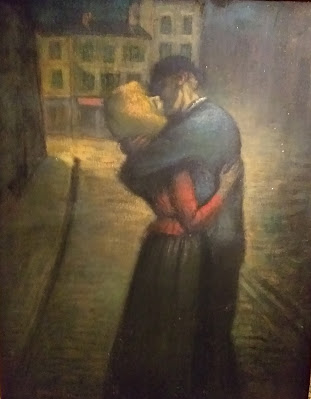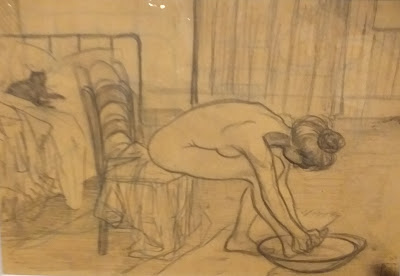 |
| La Tournée du cabaret Le Chat Noir (The Black Cat cabaret tour) 1896 Colour lithograph |
Steinlen's black cat is the emblem of bohemian Montmartre. The present exhibition commemorates the centenary of the artist's death in 1823. The poster was commissioned to advertise the famous Black Cat cabaret's road show which travelled as far as Tunisia, Algeria and Belgium. Cabaret owner- Rodolphe Salis- was Swiss, like Steinlen. The cat is generally considered as being a very independent creature- so was the cabaret. It was the haunt of the artistic community and nicknamed 'Le petit Louvre de Montmartre'. 'Le Chat Noir' was also a magazine which was published weekly from 1882 to 1895, with features on Montmartre, poems and political satire.
 |
| L'Apothéose des Chats (The Apotheosis of the cats) ca 1885 Geneva |
As the exhibition notes state- Steinlen the artist belonged to only one school of art- the school of Liberty.
Steinlen painted many cats - in groups, in pairs or alone- elegantly stretching on a divan:
 |
Cat. (non-dated) Philippe Bismuth Collection
|
 |
| Les Chats (The cats) |
The cats are portrayed realistically, or take on an art nouveau silhouette. Like Toulouse-Lautrec in his posters, Steinlen used areas of flat pure colour. Steinlen's wife Emilie and their daughter Colette were often portrayed in his advertising posters. A book of his cat illustrations was published in 1898:
Born and educated in Lausanne, Switzerland, Théodore-Alexandre Steinlen's first job was as a trainee designer in a Mulhouse textile factory. He moved to Montmartre in 1881 with his wife Emilie. He remained a devotee of bohemian Montmartre until his death in 1923.
In his various residences, he surrounded himself with felines and often used them as his models.
 |
| Steinlen 1913 anonymous photo |
When he lived at 58 rue Caulaincourt, where there was a garden, he had about 15 cats strolling around, along with pigeons, peacocks, a monkey and a crocodile called Gustave.
Steinlen was a prolific illustrator for arty, literary and satirical magazines such as Gil Blas, Le Mirliton and Le Rire, producing thousands of engravings and drawings. He occasionally used a pseudonym to avoid problems with the authorities.
He championed the rights of the lower classes and sympathised with their fate. The First World War gave him ample subjects for irony:
 |
| Journée des Régions Libérées (Day for the liberated regions) 1919 Lithography |
 |
| La Gloire (Glory) 1915 Lithography |
A mother, a wife and two sisters are shown grieving: the coffin is covered with a patriotic red, white and blue flag, while the palm branch- a sign of victory- looks stiff and dry.
In the following oil painting, Steinlen illustrates the discrepancy he saw between the present Catholic church and the original evangelizers:
 |
| L'Intrus (The Intruder) 1902 Petit Palais, Geneva |
A Christ-like figure, surrounded by children and families, faces the richly adorned religious and secular authorities. Steinlen was openly anti-clerical, as were many of his Montmartre friends.
Steinlen, who lived through the Commune revolution of 1871, was always on the side of the mistreated working masses. He took humble simple subjects, as in the following painting:
 |
| En chemin (On the way) Geneva |
His deep feeling for the people is reminiscent of Van Gogh's. Like Zola in his novels, Steinlen portrayed the reality of life for the working classes. He represented accurately their postures, just as he did with his cats. His oil painting shows women working in the coal industry:
 |
| Les Trieuses de charbon (The coal sorters) 1905 Musée d'Orsay |
He also captured intimate moments in peoples' lives:
 |
| Le Baiser (The kiss) 1895 Oil paint on cardboard Geneva |
Steinlen's nudes are naturalistic, similar to those of Degas, Toulouse-Lautrec or Suzanne Valadon:
 |
| Nu assis au bord du lit (Nude sitting on edge of bed) 1913 charcoal and pastel on paper Petit Palais, Geneva |
Several works have been loaned by Geneva's Petit Palais, now sadly permanently closed.
 |
Nu de dos assis, bras droit sur le genou (Nude from back, seated, right arm on knee) 1905
Charcoal and pastel on paper Geneva
|
 |
La Toilette du Matin (Morning toilette) 1900 pencil drawing Geneva
|
Steinlen's women might be simple working women or prostitutes. The cat in 19th century French iconography is an emblem for such women, with its sensuality inviting caresses. The women are often nameless, as in the striking portrait used to advertise the exhibition:
 |
| La Rentrée du soir (Coming home in the evening) 1897 Geneva |
The following realistic portrait, with its glowing colours, was left to the state by Steinlen's daughter, Colette:
 |
| La Pierreuse ( The prostitute ) between 1859 and 1923 Musée d'Orsay |
After the death of his wife in 1910, Steinlen made some beautiful portraits of his housekeeper Masseïda:
 |
| Portrait of Masseïda 1912 Geneva |
He portrayed her honestly and with respect. Steinlen left her a number of works on his death in 1923.
 |
| Portrait of Masseïda After 1911 charcoal on paper Musée Alphonse-Georges-Poulain, Vernon |
The Chat Noir poster at the beginning belongs to the collection of the Montmartre museum. Other permanent items include black cut-out figures used in the cabaret's popular shadow play shows. With background lighting, the figures, made of zinc (originally cardboard) were paraded across a small screen, with a piano accompaniment and a narrator to read the story. This is of course just before the advent of cinema.
The museum also houses Suzanne Valadon's studio, authentically restored. Valadon, mother of painter Utrillo, earned her living as an artist's model, but became a painter in her own right, learning from the artists she posed for- such as Renoir and Toulouse-Lautrec.
 |
| Suzanne Valadon's studio |
A short walk down the Northern side of the hill from the museum, there is a monument to the artist Steinlen in a little garden:
 |
| Monument to the memory of Steinlen by Paul Vannier 1936 |
Théophile-Alexandre Steinlen (1859-1923) Centenary Exhibition at
Musée de Montmartre, Jardins Renoir, 12 rue Cortot, Paris 18e.
from 13th October 2023 until 11th February 2024.
*************





















Comments
Post a Comment